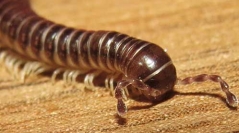

 European Journal of Taxonomy
867 (1) - Pages 1-312
European Journal of Taxonomy
867 (1) - Pages 1-312Abstract. In order to provide a reassessment of the Neotropical genus Pseudonannolene Silvestri, 1895, a cladistic analysis, biogeographic analysis, and taxonomic review were conducted in the present work. For the cladistic approach, 91 morphological characters were scored for 53 terminals as the ingroup and 10 as the outgroup. Three synapomorphies support the monophyly of the genus: presence of a longitudinal suture on the promentum, penial bases partially fused, and the internal branch of the gonopods surrounding the telopodite; and two homoplastic transformations: the lateral lobe of the collum densely striated and setae present up to the apical portion of the prefemoral process on the first leg-pair of males. The genus Pseudonannolene is recovered as sister-group of Epinannolene Brölemann, 1903 (Pseudonannoleninae). A total of 226 occurrence points were recorded for Pseudonannolene, with the majority of records from the Chacoan subregion, composed by Araucaria Forest, Atlantic, and Parana Forest provinces. The biogeographical searches using the Geographically explicit Event Model recovered two biogeographic reconstructions (cost of 79 000), with the vicariance events occurring more frequently in the deep clades, whereas sympatry and points of sympatry occurred in more inclusive clades. The first reconstruction recovered four vicariances, 13 sympatries, 4 points of sympatry, and 21 founder events, and the second reconstruction recovered four vicariances, 12–13 sympatries, 4–5 points of sympatry, and 21 founder events. The genus Pseudonannolene comprises 56 species, including 8 new species herein described: P. alata sp. nov., P. aurea sp. nov., P. bucculenta sp. nov., P. curvata sp. nov., P. granulata sp. nov., P. insularis sp. nov., P. morettii sp. nov., and P. nicolau sp. nov.; P. brevis Silvestri, 1902 and P. rugosetta Silvestri, 1897 are regarded as species inquirendae; a neotype of P. alegrensis Silvestri, 1897 is here proposed with male described for the first time. The following taxa are synonymized: P. canastra Gallo & Bichuette, 2020 and P. saguassu Iniesta & Ferreira, 2013 with P. ambuatinga Iniesta & Ferreira, 2013; P. marconii Iniesta & Ferreira, 2013 with P. longicornis (Porat, 1888); P. chaimowiczi Fontanetti, 1996, P. gogo Iniesta & Ferreira, 2013, P. rosineii Iniesta & Ferreira, 2014, P. taboa Iniesta & Ferreira, 2014, and P. longissima Iniesta & Ferreira, 2014 with P. microzoporus Mauriès, 1987; P. tricolor gracilis Brölemann, 1902 and P. tricolor rugosus Schubart, 1945 with P. tricolor Brölemann, 1902; P. auguralis Silvestri, 1902 with P. rocana Silvestri, 1902; and P. abbreviata Silvestri, 1902 with P. typica Silvestri, 1895. P. inops Brölemann, 1929 is proposed here as new status from P. bovei inops. A dichotomous identification key is presented to facilitate the species identification.